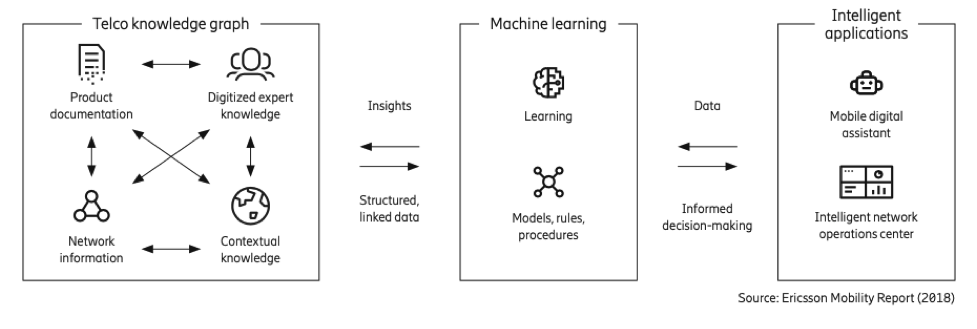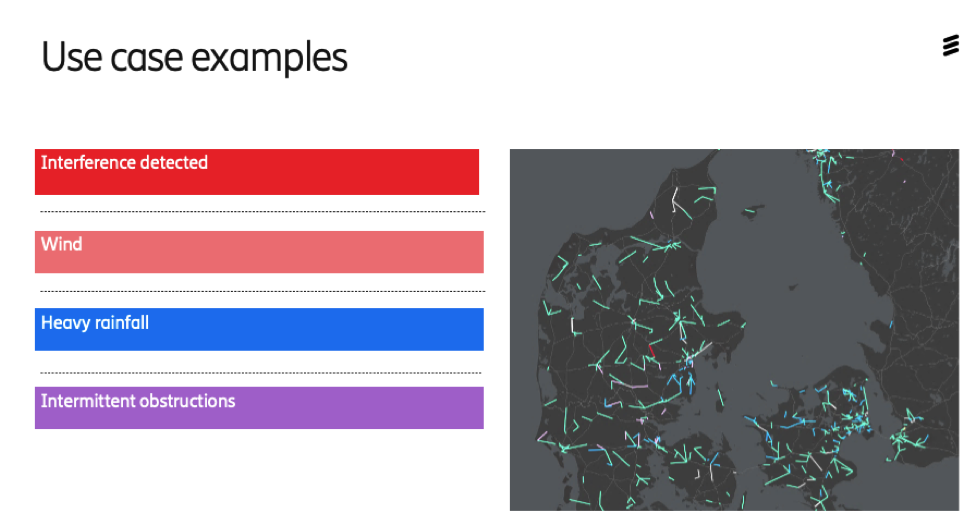As our wireless communication networks continue to advance and deliver connectivity to more people and more places, providers are turning to all sorts of technologies to increase capacity and performance.
While 5G, the next generation of cellular technology will bring advanced spectrum sharing techniques, it will also bring the need for new infrastructure, and a much more demanding coordination between that infrastructure.
As 5G adoption spreads and networks become more advanced, operators are looking for help from Artificial Intelligence (AI) and machine learning to manage the complexity.
The role of structured knowledge is enabling machine intelligence and intelligent applications

Providers have already been incorporating AI into networks for the past few years, with a primary focus on reducing capital expenditure, optimizing network performance and building new revenue streams.
Further, tools like Ericsson’s Advanced Microwave Insights are utilizing the power of AI and machine learning to collect data from the network, analyze it and then present near real-time root-cause classification of transmission issues. This kind of tool gives operators an overview of their network while delivering visibility into the status of each transport link. The operator will be alerted to when, and perhaps more critically, why a link is down or underperforming.
“This insight leads to improved network quality because you can state the problem in a better way and the performance will improve,” Ericsson’s Strategic Product Manager for Advanced Microwave Insights Ulrica Wållgren-Malmberg clarified. “Instead of troubleshooting, you can work on preventative actions.”
Of course, the valuable insight offered by AI doesn’t come from thin air. It is critical to supply an AI-based system with large amounts of data and to train the algorithms within the system to that it can apply this knowledge to provide near real-time root-cause analysis of any transmission issues, which is a time-consuming and challenging process.
Advanced Microwave Insights, which now has nearly 20,000 connected links on its system, is built with five years’ worth of data from tens of thousands of links, making it a powerful and intelligent predictive tool.
“It has taken five years of tuning and learning to actually produce this product, and to learn enough about all of the different network impacts,” Wållgren-Malmberg explained further.
AI in microwave links
The conversation around the efficacy of using microwave links as opposed to fiber for backhaul in mobile networks has been slightly skewed by the input of those countries considered to be rich in fiber, resulting in a somewhat incorrect assessment that fiber is the “better” choice.
For instance, according to Ericsson’s Product Marketing Manager for Microwave Products Maria Edberg, if you include fiber-rich countries, like the U.S. and China, 40% of all the mobile transport around the world is done by Microwave, but if you take a step back and disregard those countries rich in fiber, it’s 60% of transport that is done by microwave around the world.
“There are so many different microwave possibilities,” Alex Heredia, Customer Solutions Sales Director at Ericsson, added. “Just as radio has grown in capacity, going from 4G to 5G, microwave has developed in just the same way. Microwave is fully capable of delivering 5G transport capacity on backhaul and fronthaul for rural, suburban and urban sites.”
As Shane McClelland, Ericsson’s VP, Strategy and Business Development, Head of Transport, wrote in a blog post, “Technological advances in microwave transport like Adaptive Modulation, Radio Link Bonding, Multi-band booster, and MIMO enable microwave connections at 10Gbps, are enabling 5G-Ready microwave transport. Research and Development ongoing now in the D and W microwave bands show promise for 100Gbps microwave transport.”
The operators’ consideration is not about microwave’s ability to handle the capacity of the networks, but rather how microwave can help time to market and lower costs.
“Fiber might not be available for six months or a year,” explained Heredia,” and the cost can be so high that it is more convenient to bring in microwave. We don’t see really any limitation in terms of the use of microwave for 5G networks. 5G networks will be denser, and fiber is not going to be available at every site. Even fiber rich operators are going to struggle with this and are forecasting an increase in the use of microwave.”
In fact, while 10 to 15% of backhaul in the U.S. is currently using microwave, Heredia said it is expected that with 5G, it could be more like 15 to 20%.
With microwave gaining in popularity, so too is the opportunity of combining it with the power of AI and machine learning to improve network performance, cut costs and avoid unnecessary site visits.
“Site visits cost a lot,” said Wållgren-Malmberg, providing a hypothetical situation in which a network link has failed, but the operator does not know the cause.
“If you go to the site, you probably have new hardware with you to exchange with the old hardware,” she continued, “but depending on the reason for the failed link, you may still have the same problem when you get home.”
Because, in many cases, the problem isn’t the hardware.
This is a frustrating and common occurrence in the world of network management; however, AI and machine learning tools can help operators avoid situations like this, saving both time and money.
AI in action
When sharing his thoughts on the value of AI and machine learning, Glenn Landgren, Transmission Manager from 3, Denmark, first pointed out that when compared to fixed and fiber optics, wireless transport is more likely to encounter obstacles, such as weather events, line-of-sight issues and installation challenges. Then, he explained that those types of events all leave traces.
“They leave digital patterns and it turns out that AI models today are very powerful and can recognize and understand those patterns,” he said. “With AI, we can actually understand what events caused most errors and outages in our networks. We could understand when, we could understand where and we could understand why.”
AI tools can differentiate between several different root causes based on the digital pattern of the link, such as radio interference, obstruction, heavy rain and antenna alignment shifts caused by wind. Then, operators can take action based on that root cause.
For example, if, during a period of heavy rainfall, the AI system indicates a drop in signal, it will also alert the operator to the probable cause: the weather. The system has learned to identify this particular type of signal drop as being tied to rainfall.
At this point, the operator can decide to simply monitor the affected link’s performance, rather than send someone out to check on it. When the rain clears up and the signal returns to normal metrics, the operator can confirm that no action is necessary because it was not a problem from a link perspective.
“We can identify the reason behind the disturbance, and the fact that there is nothing wrong with the equipment,” Wållgren-Malmberg explained. “That makes it easier for the operator to understand what is happening, and what kind of disturbance it is.”

Landgren also spoke to situations in which action, and sometimes preventive action, needs to be taken, commenting, “With AI, we could build a feed-back loop from reality back to our planning tools, so if we implement this well, we can actually improve the way our planning tools predict performance and availability.”
For instance, a link might be impacted by rain, but a heavy wind has also shifted the antenna alignment slightly. With an AI tool, the operator can determine that the degradation caused by the wind, while not impacting the site performance now, should be proactively addressed in maintenance to prevent more damaging performance impacts in future storms if the antenna is pushed further out of alignment.

With interference issues AI-based management systems can detect where a microwave link is impacted by an interferer, reducing the time to resolution.
“Basically,” Wållgren-Malmberg summarized, “we understand what and where the interferer is, so we can handle it in an optimal way.”
AI and Machine Learning, when trained by sufficient real-world data, are poised to revolutionize design, optimization and maintenance of mobile networks in both RAN and transport domains. For operators considering increased microwave links for their 5G site deployments, tools are already available to improve network performance and cut costs.

